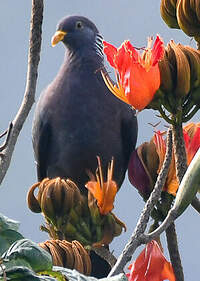Comoro Olive Pigeon
Columba pollenii - Pigeon des Comores
Identification
Comoros Olive Pigeon does not have sexual dimorphism. At 40 cm, it is the largest columbid of the Comoros archipelago and not the most colorful. Generally, it is brown-gray with purple variants. It has a head, neck, chest and brown-gray mantle with closer purple shades. The belly is light gray. In flight, the remiges are dark gray, the scapulars and wing coverts are light gray with some white spots. The tertiaries, secondaries and rectrices are dark brown, the primaries are slate black and the rump is dark gray. On the neck are fine white stripes that form serrated lines on a brown background. The bill and legs are bright yellow. The iris is dull yellowish green. A pale yellow orbital skin surrounds the eye. The juvenile is duller and browner. The adult plumage quickly appears as with all pigeons.
Subspecific information monotypic species
Foreign names
- Pigeon des Comores,
- Paloma de las Comoras,
- pombo-das-comores,
- Komorentaube,
- comore-szigeteki olajgalamb,
- Comorenolijfduif,
- Piccione oliva delle Comore,
- komorskogsduva,
- Komordue,
- holub komorský,
- holub komorský,
- Comorerolivendue,
- komorienkyyhky,
- colom de les illes Comores,
- gołąb śniady,
- Коморский голубь,
- コモロオリーブバト,
- 科摩罗林鸽,
- komorskogsduva,
- 科摩羅林鴿,
Voice song and call
Habitat
Behaviour character trait
Each Comoros Olive Pigeon has its own forest home, but it is a species capable of flying long distances between resting sites and feeding grounds. However, just like the Rameron Pigeon, this only applies to certain individuals. Seen alone or in pairs, the breeding season for these birds runs from April to November, but it is believed they can breed year-round depending on the availability of food.
Flight
Dietfeeding habits
Reproduction nesting
The nest of twigs, grass and leaves is usually placed high in trees, up to 15 metres from the ground, in the middle of thick foliage. It prefers inside forests even if it can settle at the edge of clearings. Generally only one white and shiny egg is laid, rarely two. Both adults take part in feeding the chicks. Incubation lasts between 17 and 20 days.
Geographic range
Threats - protection
IUCN conservation status
concern
in the Wild
threatened
evaluated
The Comoros Olive Pigeon is currently considered almost threatened. It is a little-known species with a restricted range on the small islands and the populations require monitoring.
It is becoming rare due to the loss of habitat and it is unable to adapt to the disappearance of the forest which could be fatal to it.
Sources of information
- IOC World Bird List (v15.1), Gill, F and D Donsker (Eds). 2025-12-07.
- Pigeons and Doves, David Gibbs, Eustace Barnes and John Cox
- Les Oiseaux de Mayotte, Clément Michel, Grissac Philippe, Rolland Robin
- Oiseaux des iles de l'océan Indien, Langrand Olivier, ian Sinclair
- BirdLife International, BirdLife International
- Avibase, Lepage Denis
Other sources of interest
 Specification sheet created on
25/07/2023 by Nathalie Santa Maria
Specification sheet created on
25/07/2023 by Nathalie Santa MariaTranslation by AI Oiseaux.net
© 1996-2025 Oiseaux.net
- Accipitriformes
- Aegotheliformes
- Anseriformes
- Apodiformes
- Apterygiformes
- Bucerotiformes
- Caprimulgiformes
- Cariamiformes
- Casuariiformes
- Charadriiformes
- Ciconiiformes
- Coliiformes
- Columbiformes
- Coraciiformes
- Cuculiformes
- Eurypygiformes
- Falconiformes
- Galliformes
- Gaviiformes
- Gruiformes
- Leptosomiformes
- Mesitornithiformes
- Musophagiformes
- Nyctibiiformes
- Opisthocomiformes
- Otidiformes
- Passeriformes
- Pelecaniformes
- Phaethontiformes
- Phoenicopteriformes
- Piciformes
- Podargiformes
- Podicipediformes
- Procellariiformes
- Psittaciformes
- Pterocliformes
- Rheiformes
- Sphenisciformes
- Steatornithiformes
- Strigiformes
- Struthioniformes
- Suliformes
- Tinamiformes
- Trogoniformes
















